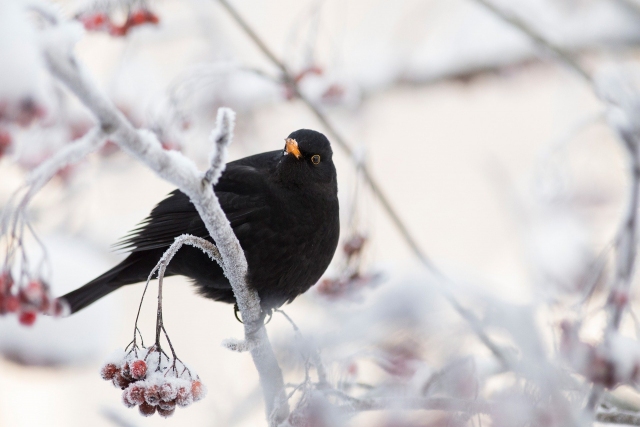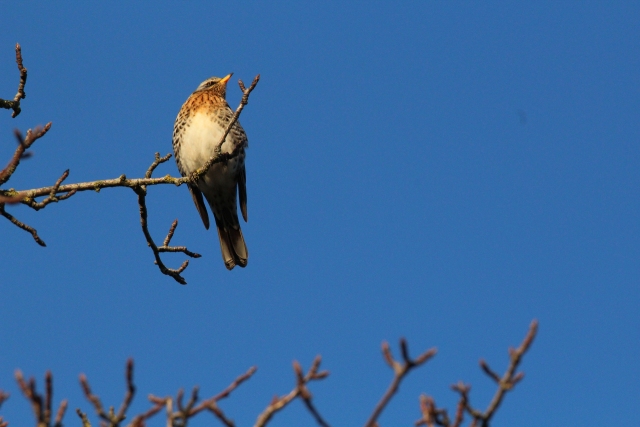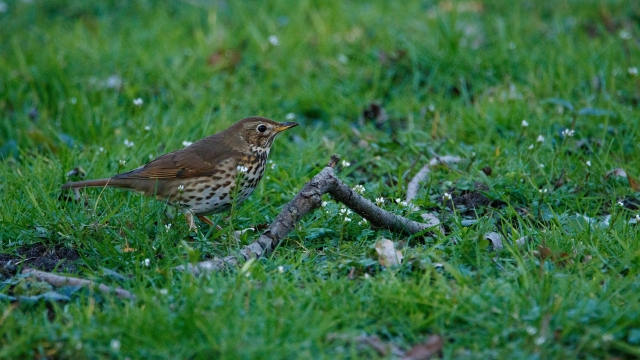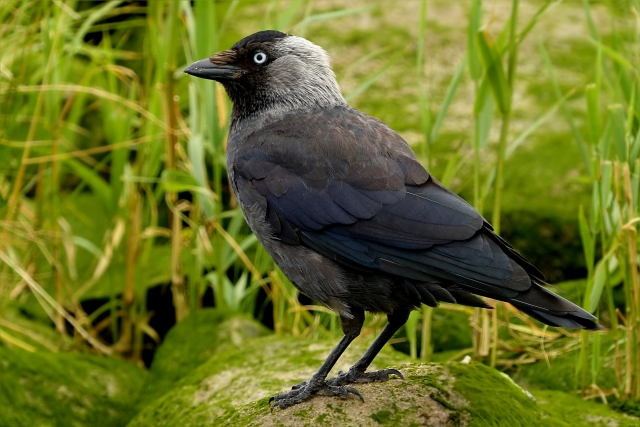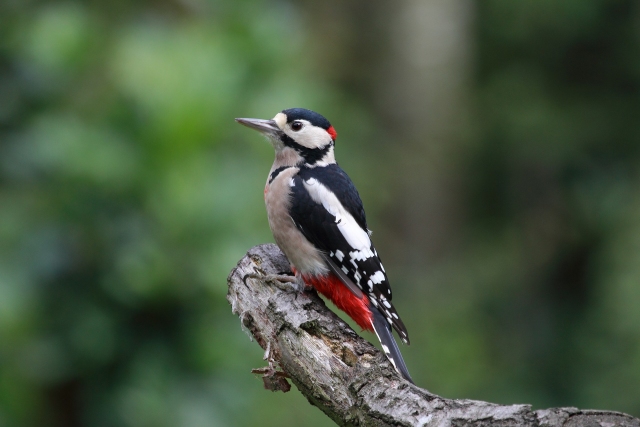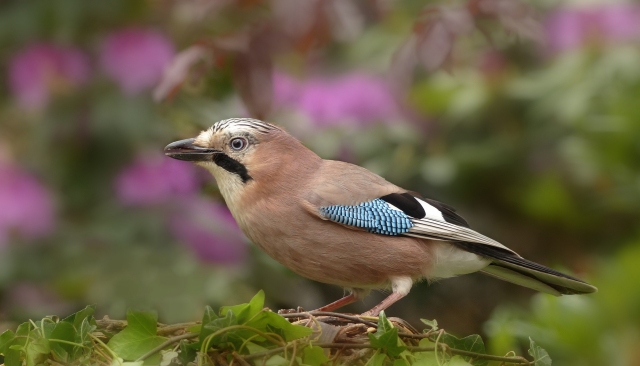Florian Heigl
European quail
Description
Adult males, also called quail cocks, have an overall grey-brown colouration with a multitude of reddish-brown and black streaks. On the middle of the head as well as on the sides of the crest, the white shaft lines of the feathers form three longitudinal stripes. The sides of the head are dark dashed. A reddish band runs from the angle of the beak, enclosing the whitish throat at the side. This reddish band is in turn bordered by an indistinct creamy white band with a narrow brown edge. A brown stripe runs across the middle of the throat. The upper chest is cream coloured with small white longitudinal stripes, changing to white-grey in the lower chest area, which also extends over the belly.
The front dorsum has black horizontal stripes and spots, the white shaft stripes of the feathers give a longitudinal pattern. The wings are grey. Wing coverts and wing feathers have a transverse pattern of thin whitish stripes. The rump and upper tail are dark with a transverse pattern of broad black and narrow reddish and white stripes.
The females, also called quail hens, are very similar to the males. However, they are usually only a solid white-grey on the breast and fore-neck. The band bordering the throat only extends to the side of the throat.
Both the cocks and the hens have a small and curved beak. The size of the quail is about 15 to 20 cm, its weight about 90 to 110 grams. Adult birds moult part of their small feathers in March and April. The annual complete moult begins in the second half of June, but moulting times can vary greatly from individual to individual.
Young birds are coloured similarly to females, but their plumage is slightly duller. The chicks are pale yellowish beige on the underparts. The upperpart of the body is orange-beige with a dark forehead patch. Starting from the forehead patch, two parallel, dark parietal stripes extend to the nape of the neck. A blackish brown central stripe runs down the middle of the back to the tail. There are two dark stripes on each wing.
Due to their small size and predominantly grey plumage, quails cannot be confused with any other species in Central Europe.
Habitat
The habitat of the quail are open fields and meadows with a high herb layer providing cover. It prefers areas with deep to somewhat moist soils. Typical breeding habitats are cereal fields, fallow land, alfalfa and clover fields. However, it also occurs in salt marshes with salt weed stands and in loamy wormwood steppes. At higher altitudes, it also inhabits meadows surrounded by forest.
The text is a translation of an excerpt from Wikipedia (https://de.wikipedia.org/wiki/Wachtel_(Art)). On wikipedia the text is available under a „Creative Commons Attribution/Share Alike“ licence. Status: 14 December 2021
Common blackbird
Description
The plumage of the males is solid black, the beak is strikingly light yellow to orange. In addition, males show a distinct ring around the eyes, the colour of which is similar to that of the beak, but can be somewhat brownish. This eye ring contrasts strongly with the dark brown iris. This eye ring is less distinct in the female, and the beak is also less conspicuous and light horn-coloured instead of yellow. The plumage colouration of the female is much more variable and predominantly dark brown, sometimes going into grey or reddish brown. The legs and toes of both sexes are dark brown. Compared to the smaller starling, which also has dark feathers and often stays on the ground, the blackbird has a much longer tail.
plumage of adult common blackbirds
The upperparts of females are dark olive-brown to olive-grey in colour, the forehead often slightly less dark. The colouration of the lighter underparts varies greatly from individual to individual. The chin and throat are light dirty grey to reddish brown with dark stripes. The chest is brown-grey, yellow-brown to reddish-brown with more or less distinct speckles. The belly is brown, grey-brown or grey, sometimes with a distinctly scaled appearance due to a pale terminal fringe of feathers. The tail feathers are dark to blackish brown, primaries and secondaries dark brown with olive tinted outer vanes.
Habitat
The blackbird originally preferred to live in the interior of moist, dense forests. Even today, it breeds in the dark locations of undergrowth-rich forests and forages on vegetation-free or short-grassed ground. In such a habitat, the blackbird's vision, which is exceptionally good for songbirds in twilight, is certainly an advantage. At the other end of the extraordinarily broad habitat spectrum today are the busy centres of large cities, so that because of this contrast the terms woodland and urban blackbird have become common.
Today, the blackbird occurs in almost all types of cultivated landscape. Its habitats include front gardens, parks and park-like areas, groups of trees and shrubs in industrial areas, meadows, bushy heaths and largely open fields, provided they are broken up with copses or shrubs. In addition to semi-natural, old forests, monoculturally managed forests are also colonised, whereby deciduous forests are preferred to coniferous forests. The blackbird also breeds in reeds. In all habitats, the birds, which forage on the ground, do not move too far away from vegetation providing cover.
By far the highest settlement density is achieved within built-up areas, often with four or more breeding pairs per hectare. In forests, on the other hand, the density is considerably lower, rarely more than 0.5 breeding pairs per hectare. In rural areas and villages, the settlement density is usually between that of towns and forests.
Mountain forests are also colonised by the blackbird. In the Alps, it occurs up to the timberline.
The text is a translation of an excerpt from Wikipedia (https://de.wikipedia.org/wiki/Amsel). On wikipedia the text is available under a „Creative Commons Attribution/Share Alike“ licence. Status: 14 December 2021
Common swift
Description
The shape is similar to a swallow, but the swift is slightly larger than European swallows. The wings are long compared to the body and their crescent shape is easily seen in gliding flight. The tail is relatively short and forked. Males and females cannot be distinguished externally. The plumage is sooty to brownish black except for the greyish-white throat patch, which is, however, difficult to see in flight. The face, seen from the front, appears roundish; the eyes are relatively large and the iris is deep brown. The small, black beak is slightly curved downwards. The short feet are blackish flesh-coloured. The four toes end in sharp talons; as in all swifts, they are all pointed forward.
Adult swifts weight about 40 grams on average, but the weight varies quite a bit with nutritional status. Non-breeders and swifts that have just arrived at the breeding site are usually somewhat heavier than breeding birds. The trunk length averages 17 cm, and when the wings are put on they cross and overhang the tail by about four cm. The wingspan is between 40 and 44 cm. Compared to other bird species, the primaries are very elongated; the upper and lower arms are short and compact.
The juvenile plumage is darker and less shiny, the white of the throat is more extensive and purer than in adult birds. In addition, young birds are distinguished from adults by the white feather seams, which are most conspicuous on the axillary feathers, the wing coverts, the large plumage and especially on the forehead. Only the fringes of the forehead feathers remain until the juvenile moult, while the other white fringes disappear quite soon due to wear. One-year-olds look like adult swifts; they are best recognised by the worn juvenile plumage, in which the ends of the tail feathers are more rounded.
Habitat
In Central Europe, the swift mainly breeds on multi-floor old buildings, including residential houses, church towers, factory buildings or railway stations. On such buildings, many cavities on roofs and façades are used, such as eaves or roller shutter boxes. New buildings with a dense outer skin offer hardly any breeding opportunities. Due to the availability of suitable breeding sites, swifts often settle in only a few places, such as town centres, industrial or harbour facilities, and in small towns often exclusively on churches or other historic buildings.
Swifts were originally predominantly rock-breeders, but today they are rare in Central Europe and only known from a few regions, such as the Elbe Sandstone Mountains. It is assumed that the transition from rock-breeding to building-breeding took place in the Middle Ages. Possibly, castles built of rough natural stone were the link through which the birds approached human buildings and became a synanthropic bird.
The text is a translation of an excerpt from Wikipedia (https://de.wikipedia.org/wiki/Mauersegler). On wikipedia the text is available under a „Creative Commons Attribution/Share Alike“ licence. Status: 14 December 2021
Barn swallow
Description
The barn swallow is about 19 to 22 centimetres in length, of which two to seven cm are accounted for by the tail feathers. The weight of males during the breeding season is between 16.1 and 21.4 grams, females weigh between 16 and 23.7 grams. The wingspan is 32 to 34.5 cm.
The barn swallow is very slender with a characteristic deeply forked and long tail. The back is a shiny metallic blue-black. The underpart is creamy white. The maroon colour on the throat, which is framed entirely in black, and on the forehead and chin is also characteristic. There are white spots on the tail feathers, which can be seen when the tail is spread.
Habitat
The species lives in the open cultivated landscape where there are farms, meadows and ponds. The birds spend the summer between April and September or early October in their breeding grounds. These are located throughout Europe, Northwest Africa, the temperate regions of Asia and in North America up to an altitude of about 1000 metres and as far as the Arctic Circle. Barn swallows winter in central and southern Africa. Asian wintering grounds are found in India and Iran.
The text is a translation of an excerpt from Wikipedia (https://de.wikipedia.org/wiki/Rauchschwalbe). On wikipedia the text is available under a „Creative Commons Attribution/Share Alike“ licence. Status: 14 December 2021
Mistle thrush
Description
The mistle thrush can reach a body length of about 26 to 29 cm. The body weight can be up to 140 grams. The mistle thrush resembles the song thrush, which, however, only grows to a maximum length of 22 cm. The upperpart is grey-brown and the underpart is white with dark brown spots. The underwing is white. Males and females have the same colouration.
Habitat
The mistle thrush lives in sparse forests, parks and smaller woods in Central Europe. In the south of its range it is mainly found in the mountains, but in central and western Europe it is increasingly found in towns and villages. Most mistle thrushes migrate to south-western Europe in autumn and spend the winter there.
The text is a translation of an excerpt from Wikipedia (https://de.wikipedia.org/wiki/Misteldrossel). On wikipedia the text is available under a „Creative Commons Attribution/Share Alike“ licence. Status: 14 December 2021
European song thrush
Description
With a body length of 20-22 cm, the song thrush is somewhat smaller than a blackbird and also appears more delicate and short-tailed. The wing length averages 80 mm. The average weight in winter is about 70 g, the minimum weight at the end of the breeding season is 60 g. If fat deposits have been built up at migration time, a song thrush can weight up to 90 g. The upper head is warm greyish-brown.
The top of the head is warm grey-brown, with a lighter over-eye stripe indicated, but usually only in the area of the forehead. The lore are dark brown and show a light speckling. The ear coverts are light brown. The nape, sides of the neck and front of the back are warm brown, the rest of the upperparts are greyish brown to olive brown. The chin and front throat are beige to cream, the front chest and flanks are overlaid with a yellowish brown colouration, which blends smoothly into the dull white of the rear chest and belly. The underparts are also patterned with blackish-brown spots, which are elongated and narrow on the chin and throat and become denser into a moustachial stripe. This is set off by an unpatterned, light-coloured edge towards the brown rein. Towards the belly the spots become larger as well as roundish fan-shaped and form implied rows. In spring they can look inverted V-shaped or heart-shaped. Towards the flanks they sometimes become lighter, on the underbelly more sparse. The rectrix and wing feathers are largely brown with a reddish brown, lighter outer plume. The three inner secondaries are often indistinctly light fringed. The greater and middle coverts bear a pale lace patch. The underwing coverts are rusty yellow and stand out clearly in flight from the otherwise rather greyish brown to grey underwing.
The eye is dark brown with a cream-coloured ring. The beak is blackish brown with yellowish underbeak branches. The feet are yellowish brown to brownish pink in adults and pinkish pearly in juveniles.
Sexual dimorphism is not pronounced. Only the average size of males is slightly bigger.
In juvenile plumage the upper side is warmer brown and shows an intense cinnamon yellow blotch on shoulders and back. The underpart is more yellowish than in adults, and the spotting on the underpart is less contrasting.
The song thrush can be confused with the mistle thrush, which is, however, one fifth larger, has a teardrop-shaped round, very coarse mottling on the underpart and is rather dull grey-brown above. The tail, which appears much longer, shows white tips on the outer feathers and the flight is wavy. The red-winged thrush is also similar, but smaller, showing strong fox-red flanks and the same underwing coverts in flight. In addition, the underpart is more streaky and the head pattern of light over-eye streak and light moustachial stripe is much more distinct.
Habitat
The song thrush inhabits a variety of forest types, but shows a preference for conifers, much and dense undergrowth, shade and high humidity. Unlike other thrush species, it does not depend on forest edge habitats or open areas for foraging. It is particularly fond of spruce regrowth as a nesting site.
In the Alps and the low mountain ranges, it is particularly common in forests with spruce and silver fir. These can be pure coniferous forests, but also mixed forests with spruce interspersed and undergrowth. It is usually rarer in pure deciduous forests.
In the lowlands, it occurs in all types of forest except in beech woods without undergrowth and similar habitats. However, young spruce afforestations and moist, undergrowth-rich habitats such as riparian or moor forests are preferred. It also occurs here in smaller habitats such as juniper heaths, field copses, rows of poplars with undergrowth and the like. Since the beginning of the 20th century, it has also increasingly penetrated urban habitats such as garden settlements, parks or cemeteries.
The text is a translation of an excerpt from Wikipedia (https://de.wikipedia.org/wiki/Singdrossel). On wikipedia the text is available under a „Creative Commons Attribution/Share Alike“ licence. Status: 14 December 2021
Eurasian jackdaw
Description
The eurasian jackdaw is a medium-sized corvid with a body length of 33-39 cm. It appears stocky - especially in comparison with most ravens and crows - and has a stout, strong beak and relatively short legs. The jackdaw's tail is of medium length and slightly rounded in comparison to the genus, its wings are round, weakly digitated and fall slightly behind the tail when attached. Male jackdaws grow larger on average than females, although there is overlap in the dimensional ranges: Males reach a wing length of 208-255 mm and a tail length of 122-138 mm. Their beak grows to 20.6-21.5 mm from the nostrils to the tip, and the male tarsometatarsus 42.3-49.0 mm. The male weight is 174-300 g. With 205-250 mm wing length, 115-134 mm tail length, a 19.8-23.2 mm long bill and 41.2-46.5 mm length of the tarsometatarsus, and a weight of 175-282 g, females achieve only slightly smaller maximum measurements, but significantly smaller mean values.
The sexes are very similarly coloured, differing at most in a slightly lighter colouration of male birds at certain times of the year. The nasal bristles, forehead, crown, eye area, cheeks and chin down to the throat are black in adult jackdaws. The black head plate has a metallic blue or violet shimmer. The back of the crown, the back of the head, the nape of the neck and the ear coverts contrast with the black crown due to their light to slate grey coloration, but merge into black in the cheek, throat and nape area. On the sides of the neck and in the nape of the neck, some individuals develop a sometimes more, sometimes less distinct, silver-grey band, which becomes broader towards the breast and separates the plumage of the head from the body plumage. The eurasian jackdaw's back, like its wings and tail, is black-grey to black.[2] The wing feathers have a faint greenish or bluish sheen. The underparts - breast, flanks, belly and abdomen - are slate grey and darker than the back of the head. From moult to moult, especially the grey areas of the plumage fade. In black feathers, usually only the edges fade, resulting in a scaly pattern on the back. The nasal bristles turn rusty brown with time. Old birds have a whitish-blue iris, which contrasts strikingly with the black facial plumage. Their beak is black, as are their legs.
Juveniles differ from adults in colour only in a few details. Their plumage colours are duller and have much less sheen than adults. The black parts of the adult plumage appear more brownish or greyish, and the colour separation of the head plate from the back of the head is less distinct. The most obvious difference is the eye colour: after the juvenile moult, the iris colour of the birds changes from light blue to dark brown. Only after about one year does it become lighter again on the outside, and from the third year of life it is completely white-blue again.
Habitat
The availability of potential breeding sites and suitable areas for foraging influence the habitat selection of the eurasian jackdaw. As a predominantly cavity-nesting bird, it is strongly dependent on old wood stands with woodpecker cavities, on rock holes or on buildings with sufficient niches in its habitat, at least during the breeding season. Quarries, rocky coasts, settlements with old buildings, medieval churches as well as parks and groves with large, old trees are therefore frequently used breeding habitats by the jackdaw. They also serve as roosting sites outside the breeding season. Forests are colonised only at the edges (maximum 2 km from the forest edge).
The species needs relatively wide open areas to forage on the ground. These areas must have low vegetation (maximum 15-20 cm) so that the eurasian jackdaw can move around on them, so parkland and pastureland are preferred. Because they should also be rich in insects, the bird likes to use dry grasslands and extensively cultivated areas. In the course of the year, the eurasian jackdaw uses very different areas - pastures, steppes, stubble fields, floodplains - for foraging.
The eurasian jackdaw is relatively weather and temperature tolerant, but avoids extremes of heat and cold. It is more likely to be found in lowlands and valleys than in mountainous areas. Below 500 m it is usually widespread, between 500 and 1000 m it is often found only in local aggregations. In some exceptional cases, breeding habitats extend beyond 1000 m, for example in the Alps, in the Atlas or in Kashmir up to about 2000 m. Outside the breeding season, it can also be found at altitudes of up to 3500 m.
The text is a translation of an excerpt from Wikipedia (https://de.wikipedia.org/wiki/Dohle). On wikipedia the text is available under a „Creative Commons Attribution/Share Alike“ licence. Status: 14 December 2021
Eurasian collared dove
Description
The eurasian collared dove is 31 to 33 cm in length and thus about the same size as the feral dove. However, it is lighter and longer-tailed, making it appear slimmer and more delicate. Its wingspan is 47 to 55 cm; it weighs 150 to 200 grams. The plumage is uniformly light beige-brown, the wing tips are slightly darker, the head and underparts are slightly lighter. The reddish eye has a narrow white eye ring. The most striking feature is a deep black nape stripe in the adult plumage, which is additionally framed by a narrow white stripe. The sexes are alike.
Habitat
Eurasian collared doves are synanthropic birds. They originate from Asia, but as they found an increasingly better food supply in more northern areas of Europe through agricultural and domestic waste, they expanded their habitat over the whole of Europe in the course of the 20th century. In the meantime, they are advancing further to the north-east. Their expansion in the middle of the 20th century could be observed and recorded in detail. They have now established themselves as resident birds and live in parks and gardens, always close to settlements, preferably in quiet residential areas where there are a few conifers. They need the latter, as they prefer to breed in conifers. They are not very shy.
The text is a translation of an excerpt from Wikipedia (https://de.wikipedia.org/wiki/Türkentaube). On wikipedia the text is available under a „Creative Commons Attribution/Share Alike“ licence. Status: 14 December 2021
Great spottet woodpecker
Description
The great spotted woodpecker is about 23 cm tall. Its wingspan is between 34 and 39 cm. It weighs between 60 and 90 grams. Its plumage is black on top with two large white wing spots and yellowish-grey underneath. The undertail coverts are a vivid red. Only the male has a red nape patch and juveniles have a red crest. The cheeks are white, the part above the beak rather grey. There are black stripes on the sides of the neck.
Great spotted woodpeckers have pointed, curved talons on their climbing feet, which they use to hold on to the bark. Two talons point forwards and two point backwards. Their skin is unusually thick, which protects them from insect bites. A flexible, joint-like connection between the broad base of the beak and the skull absorbs the vibrations that occur when carving the woodpecker's cavity. The upright and stable posture on the tree is supported by strong muscles that control the supporting tail feathers. To prevent inhalation of the resulting wood flour, the nostrils of the great spotted woodpecker are covered with fine feathers.
Visually similar and therefore easily confused with the great spotted woodpecker in Central Europe are the middle spotted woodpecker, the lesser spotted woodpecker, the white-backed woodpecker and the syrian woodpecker, but all of them occur much less frequently in Austria.
Habitat
The great spotted woodpecker is the least specialized native woodpecker species and therefore the most common. It can be found in both deciduous and coniferous forests, but also in parks and in cultivated landscapes, provided there are avenues, shelterbelts or small groups of trees. Mixed oak and beech forests with a lot of old and dead wood are optimal habitats for it. Monotonous pure spruce stands have only low woodpecker abundance.
The text is a translation of an excerpt from Wikipedia (https://de.wikipedia.org/wiki/Buntspecht). On wikipedia the text is available under a „Creative Commons Attribution/Share Alike“licence. licence. Status: 17 December 2021
Eurasian jay
Description
With a body length of 32 to 35 cm, the eurasian jay belongs to the medium-sized corvids, its wingspan is about 53 cm and its weight is about 170 grams. The strong beak is greyish-black to black. The feet are greyish-brown to brown flesh-coloured with yellowish or whitish soles. The iris is bluish-grey with a reddish inner and outer ring and an equally fine speckling.
The sexes do not differ in plumage colouration. The head is more or less conspicuously marked depending on the subspecies. The eurasian jay has white parts on the forehead and crown, the narrow, elongated feathers of which are streaked with black and can be raised to form a bonnet when excited. The region around the eye is also white with black streaking, often except for the front ear coverts. There is also a distinct black beard stripe, which is about the size of the beak. Chin and throat are white. The back of the ears, sides of the neck and the nape are reddish beige to dull chestnut. This colouration continues on the back, shoulders and underparts, turning more greyish brown on the back and slightly lighter on the underparts. The middle of the belly and the under-tail coverts are white, as are the back and the rump. The latter feature is often very noticeable, especially in flight, and contrasts with the blackish-brown colouring of the rectrix. The base of the feathers is grey with a grey-blue cross banding, which is hidden by the upper tail coverts. The tail ends with a relatively straight edge.
The roundish, broad wings are strikingly and characteristically coloured. The beige-pink colouring of the upper side continues on the lesser and middle coverts. The primary coverts and greater coverts are black on the inner vane and bear a black cross banding on the outer vane on a sky-blue background. This colourful plumage, which forms a blue field below the shoulder when the bird is sitting, is a particularly characteristic feature of the species. The primaries are dark brown with a pale fringe, which increasingly bears a blue-black cross banding towards the inner primaries. The secondaries are blackish brown with a white outer plume towards the base of the feathers. These form a white field when the wing is folded and are also clearly visible in flight. Sometimes there is a blue-black band in the white areas, mostly not visible. Towards the brown-black tertials, several secondaries show a chestnut-brown colouration with a broad, black terminal fringe.
Habitat
In Central Europe, the eurasian jay inhabits deciduous, mixed and coniferous forests during the breeding season. It prefers sparse stands with a rich lower tree layer or a high shrub layer, or richly structured forests in which small areas alternate with different age classes, clearings, densities or slash. In monotonous forest forms such as spruce or pine forests, but also, for example, beech forests, it occurs in low density, only in marginal areas or in the area of clearings and slashes.
In correspondingly forest-like habitats, it also breeds close to settlements, for example in parks, extensive gardens or cemeteries. In the open countryside, the jay is rarely found during the breeding season. But after the breeding season during ripeness, it specifically seeks out solitary oaks or hazel bushes in the open landscape.
The text is a translation of an excerpt from Wikipedia (https://de.wikipedia.org/wiki/Eichelhäher). On wikipedia the text is available under a „Creative Commons Attribution/Share Alike“ licence. Status: 17 December 2021


